Warm temperatures induce transgenerational epigenetic release of RNA silencing by inhibiting siRNA biogenesis in Arabidopsis
- PMID: 23686579
- PMCID: PMC3670308
- DOI: 10.1073/pnas.1219655110
Warm temperatures induce transgenerational epigenetic release of RNA silencing by inhibiting siRNA biogenesis in Arabidopsis
Abstract
Owing to their sessile nature, plants have evolved sophisticated genetic and epigenetic regulatory systems to respond quickly and reversibly to daily and seasonal temperature changes. However, our knowledge of how plants sense and respond to warming ambient temperatures is rather limited. Here we show that an increase in growth temperature from 22 °C to 30 °C effectively inhibited transgene-induced posttranscriptional gene silencing (PTGS) in Arabidopsis. Interestingly, warmth-induced PTGS release exhibited transgenerational epigenetic inheritance. We discovered that the warmth-induced PTGS release occurred during a critical step that leads to the formation of double-stranded RNA (dsRNA) for producing small interfering RNAs (siRNAs). Deep sequencing of small RNAs and RNA blot analysis indicated that the 22-30 °C increase resulted in a significant reduction in the abundance of many trans-acting siRNAs that require dsRNA for biogenesis. We discovered that the temperature increase reduced the protein abundance of SUPPRESSOR OF GENE SILENCING 3, as a consequence, attenuating the formation of stable dsRNAs required for siRNA biogenesis. Importantly, SUPPRESSOR OF GENE SILENCING 3 overexpression released the warmth-triggered inhibition of siRNA biogenesis and reduced the transgenerational epigenetic memory. Thus, our study reveals a previously undescribed association between warming temperatures, an epigenetic system, and siRNA biogenesis.
Conflict of interest statement
The authors declare no conflict of interest.
Figures
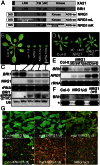
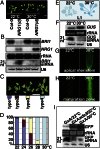
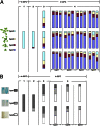
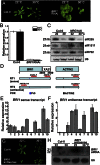
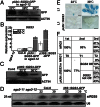
Similar articles
-
Hibiscus chlorotic ringspot virus coat protein inhibits trans-acting small interfering RNA biogenesis in Arabidopsis.J Gen Virol. 2008 Sep;89(Pt 9):2349-2358. doi: 10.1099/vir.0.2008/002170-0. J Gen Virol. 2008. PMID: 18753245
-
Distinct and concurrent pathways of Pol II- and Pol IV-dependent siRNA biogenesis at a repetitive trans-silencer locus in Arabidopsis thaliana.Plant J. 2014 Jul;79(1):127-38. doi: 10.1111/tpj.12545. Epub 2014 Jun 13. Plant J. 2014. PMID: 24798377
-
An H3K27me3 demethylase-HSFA2 regulatory loop orchestrates transgenerational thermomemory in Arabidopsis.Cell Res. 2019 May;29(5):379-390. doi: 10.1038/s41422-019-0145-8. Epub 2019 Feb 18. Cell Res. 2019. PMID: 30778176 Free PMC article.
-
[Trans-acting short interfering RNAs].Postepy Biochem. 2006;52(3):253-9. Postepy Biochem. 2006. PMID: 17201060 Review. Polish.
-
The biogenesis, regulation and functions of transitive siRNA in plants.Acta Biochim Biophys Sin (Shanghai). 2024 Sep 29;57(1):131-147. doi: 10.3724/abbs.2024160. Acta Biochim Biophys Sin (Shanghai). 2024. PMID: 39376148 Free PMC article. Review.
Cited by
-
MicroRNA160 Modulates Plant Development and Heat Shock Protein Gene Expression to Mediate Heat Tolerance in Arabidopsis.Front Plant Sci. 2018 Feb 1;9:68. doi: 10.3389/fpls.2018.00068. eCollection 2018. Front Plant Sci. 2018. PMID: 29449855 Free PMC article.
-
A review of the potential involvement of small RNAs in transgenerational abiotic stress memory in plants.Funct Integr Genomics. 2024 Apr 11;24(2):74. doi: 10.1007/s10142-024-01354-7. Funct Integr Genomics. 2024. PMID: 38600306 Review.
-
Plant Responses to Heat Stress: Physiology, Transcription, Noncoding RNAs, and Epigenetics.Int J Mol Sci. 2020 Dec 24;22(1):117. doi: 10.3390/ijms22010117. Int J Mol Sci. 2020. PMID: 33374376 Free PMC article. Review.
-
Non-coding RNAs fine-tune the balance between plant growth and abiotic stress tolerance.Front Plant Sci. 2022 Oct 12;13:965745. doi: 10.3389/fpls.2022.965745. eCollection 2022. Front Plant Sci. 2022. PMID: 36311129 Free PMC article. Review.
-
Epigenetics: possible applications in climate-smart crop breeding.J Exp Bot. 2020 Aug 17;71(17):5223-5236. doi: 10.1093/jxb/eraa188. J Exp Bot. 2020. PMID: 32279074 Free PMC article. Review.
References
-
- Long SP, Ort DR. More than taking the heat: Crops and global change. Curr Opin Plant Biol. 2010;13(3):241–248. - PubMed
-
- Lobell DB, Field CB. Global scale climate–crop yield relationships and the impacts of recent warming. Environ Res Lett. 2007;2(1):014002.
-
- Blázquez MA, Ahn JH, Weigel D. A thermosensory pathway controlling flowering time in Arabidopsis thaliana. Nat Genet. 2003;33(2):168–171. - PubMed
-
- Lin L, Zhong SH, Cui XF, Li J, He ZH. Characterization of temperature-sensitive mutants reveals a role for receptor-like kinase SCRAMBLED/STRUBBELIG in coordinating cell proliferation and differentiation during Arabidopsis leaf development. Plant J. 2012;72(5):707–720. - PubMed
Publication types
MeSH terms
Substances
Associated data
- Actions
- Actions
- Actions
- Actions
- Actions
- Actions
Grants and funding
LinkOut - more resources
Full Text Sources
Other Literature Sources
Molecular Biology Databases
Research Materials

